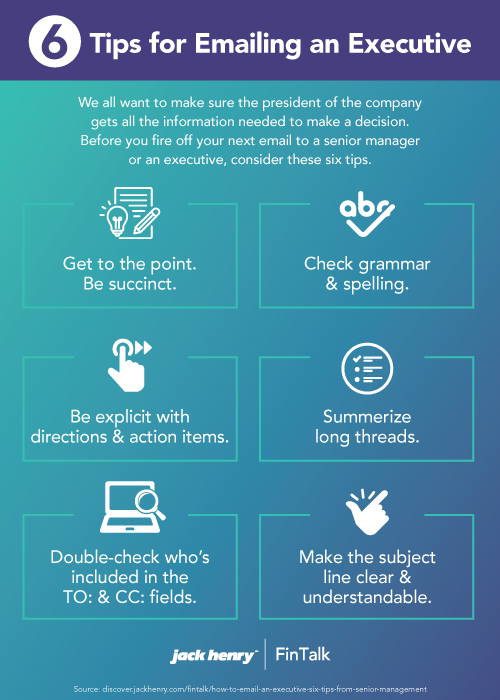
Communication at work is key – but when it comes to writing emails to senior management, things can get a little intimidating. You may be worried about nailing the grammar and portraying yourself professionally, but are these really the things senior management cares about when reading an email from someone? We spoke with senior leaders within Jack Henry & Associates to get the scoop on what they really look for and came up with six tips you can use when it’s time to send that all-important email.
This one may seem a bit counterintuitive. After all, they’re senior management, shouldn’t you include as much info as possible in your correspondence? Dealing with hundreds of emails is part of every executive’s job, which is why getting straight to the point is important.
“I like to get straight to the point unless foundational information is required to make a decision .... most of the emails I get are usually lengthy and require reading time,” said Stacey Zengel, SVP & President of Jack Henry Banking.
When constructing your email to senior management, take the time to read through and make sure you’re only including the essentials. This makes it easier for recipients to get through your email and gather the important facts.
Double-checking grammar and punctuation may seem like a no-brainer, but it’s an important tip to consider when writing emails to senior management. You want to make sure your email comes across as professional and credible. Reading through your message carefully or even popping the content into a grammar checker, like Grammarly, can help ensure your message is mistake-free. The last thing you want is for your message to come across as confusing because of a typo or an unclear sentence.
“Think about who you are including in an email, and if they need to be included. Make the email as succinct as possible. Lastly, read it for grammar and spelling – how you write/email creates a perception of you to others. I think some of our Associates forget that at times. It may not be a bad idea to have someone else read an important email before you send it for this very reason,” remarked Stacey Zengel, SVP & President of Jack Henry Banking
Not much is worse than getting a lengthy email and not knowing what you’re supposed to take away from it. When it comes to thinking about how to address senior management in an email, a big thing to consider is including takeaways or actionable items. One idea is to open your email with a brief summary and then list out the actions you need the person to take. You can use bullet points to really call out those actions needed. If there are no actions you need the person to take, explicitly tell them this information is “FYI only.”
“Be succinct – I prefer bullets to long sentences and include proper spacing to make it easier to read. Provide clear subject lines and explicit directions for actionable items so the group and/or individuals receiving the email understand what to do. Finally, if it is FYI ONLY, indicate that’s the case,” advised Jack Henry & Associate Chief Operating Officer, Greg Adelson.
Long threads are confusing and messy – but sometimes necessary in order to pass along all of the important information. It’s not unusual for executives to check email on the road from their phones. But scrolling through long threads looking for the point of an email is not a something you want to put senior management through.
“Long threads drive me nuts,” shared Russ Bernthal, former SVP & President of ProfitStars. “They’re particularly annoying when I’m traveling and looking at emails on my phone. Brevity makes a huge difference. If you send a long thread, tell me the essence of the thread in a summary at the beginning. I can look through the details if I need or want to.”
Receiving hundreds of emails a day comes with the territory of being a senior exec. But just because this is part of the gig, doesn’t mean an executive automatically understands why they’re getting an email. Make sure it’s absolutely necessary that they’re included on the email before sending it off to them. If they must be, then make clear to them why. No one – from senior executive to summer intern – likes to be included on emails that are ongoing and irrelevant.
“I would say ‘Reply All’ when not required is the biggest pet peeve for me. The second most-frustrating relates to long/drawn out emails that you are ‘CC-ed’ on versus on the ‘To’ line, but you can’t tell if the content is FYI only or requires action on your part.” said Greg Adelson, Chief Operating Officer for Jack Henry.
Think about how many emails you get in a day. If the subject line isn’t clear, you could easily overlook an important message. The same goes for executives. Making sure your subject line is clear and descriptive is one of the easiest tips to keep in mind when writing emails to senior management. It’s the first impression of your email and it helps indicate to the recipient whether or not the email is important. Keeping your subject line clear helps executives prioritize and read your email with the right mindset.
Most of these six tips for writing emails to senior management are common sense really. The main goal is to make it easy for executives to do their job and you can do that by constructing your emails in a way that helps them make a decision, take action, or approve your request. It's a small act, but a small act multiplied by 100 people can make a big difference their day. So, before you fire off your next email to a senior manager or an executive consider these tips.

Stay up to date with the latest people-inspired innovation at Jack Henry.
.svg)

Learn more about people-inspired innovation at Jack Henry.
Who We Serve
What We Offer
Who We Are